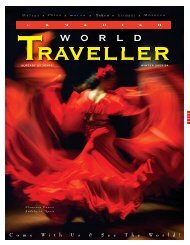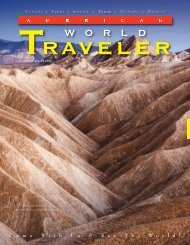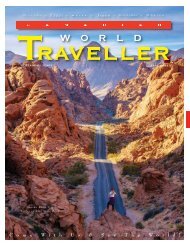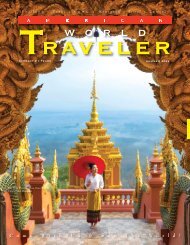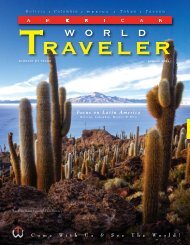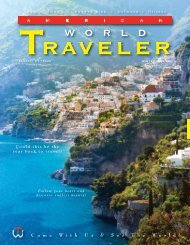Canadian World Traveller / Summer 2016 Issue
www.canadianworldtraveller.com
www.canadianworldtraveller.com
Create successful ePaper yourself
Turn your PDF publications into a flip-book with our unique Google optimized e-Paper software.
at a restaurant while listening to Nubian<br />
music. Want to spice up your food? Stop by<br />
at a local market and purchase local<br />
spices. Up for a tattoo? You can get a<br />
henna (flowering plant) tattoo while you’re<br />
here. If you want to take a bit of Aswan with<br />
you as you return home, be sure to buy<br />
souvenirs and African handmade goods at<br />
the Aswan Bazaar. Finally, if you ever have<br />
arthritis or any type of pain during your<br />
stay, you can bury your body aches in the<br />
city’s sand. Aswan also has a number of<br />
sites for people to relax and rejuvenate.<br />
Abu Simbel Temples<br />
These are two massive rock temples located<br />
in Abu Simbel, a village in Nubia, near<br />
the Sudan border. You can find the temples<br />
on the western bank of Lake Nasser, 230<br />
kilometres southwest of Aswan. To avoid<br />
being submerged by Lake Nasser, the temples<br />
were relocated in 1968. This is a<br />
UNESCO <strong>World</strong> Heritage Site; the complex<br />
is coined the “Nubian Mountains,” since<br />
they run from Abu Simbel to Philae, near<br />
Aswan. Two temples await visitors upon<br />
their arrival. The Great Temple is the<br />
largest. When you arrive at the entrance,<br />
you will see a bas-relief representing two<br />
images of the king worshipping Ra<br />
Harakhti, a falcon head. Step inside the<br />
temple and take a look at the layout. It is<br />
triangular in shape, as are most ancient<br />
temples in Egypt. The hypostyle hall is characterized<br />
by pillars representing Ramses<br />
linked to Osiris, the underworld god. This<br />
indicates the pharaoh’s everlasting nature.<br />
You’ll also see colossal statues; some of<br />
them bear a white crown of Upper Egypt,<br />
and others wear a double crown of Upper<br />
and Lower Egypt. A pillared hall follows the<br />
hypostyle hall. The pillared hall features<br />
various scenes of royalty and victories in<br />
past wars. The Small Temple is known for<br />
its statues of a king and his queen. Here’s<br />
one particularity with the Small Temple:<br />
scenes with the queen playing instruments<br />
adorn the walls. (The instrument in question<br />
is the sinistrum.) Pillars and bas-reliefs<br />
depict various scenes with pharaohs,<br />
queens, gods, and goddesses.<br />
The Western Desert<br />
Siwa Oasis<br />
This is an Egyptian oasis sandwiched<br />
between the Qattara Depression and the<br />
Egyptian Land Sea in the Libyan Desert. It is<br />
one of the country’s most isolated settlements<br />
with a population of 23,000.<br />
Agriculture is the main industry in the oasis,<br />
though tourism has become a runner-up in<br />
recent times.<br />
With respect to culture, Berber inhabitants<br />
in the oasis were talented in creating<br />
basketry, pottery, silverwork, and<br />
embroidery crafts. Dress styles were<br />
also of major significance, especially bridal<br />
silver and silver ornaments/beads women<br />
wore at events. As roads and television<br />
services made headway in the Siwa Oasis,<br />
all silver ornaments were eventually<br />
replaced by gold ornaments.<br />
Like most parts of Egypt, the Siwa Oasis<br />
has its share of festivals. The Sihaya Festival<br />
is by far the leading festival in the area. It<br />
honours Saint Sidi Sulayman, the town’s<br />
traditional patron. What happens during<br />
this festivity? The local men assemble on a<br />
mountain to eat, sing songs of thanks to<br />
God, and make peace with one another.<br />
The women remain in the village and celebrate<br />
by singing, dancing, and playing<br />
drums.<br />
Here’s a brief list of sights you might want<br />
to check out as you visit the Siwa Oasis.<br />
Mud-brick houses in Shali, an old town<br />
Desert sand dunes south of Siwa<br />
Siwa salt lake<br />
Temple of the Oracle of the Amun<br />
www.egypt.travel<br />
29<br />
<strong>Canadian</strong> <strong>World</strong> <strong>Traveller</strong> <strong>Summer</strong>/Fall <strong>2016</strong>







